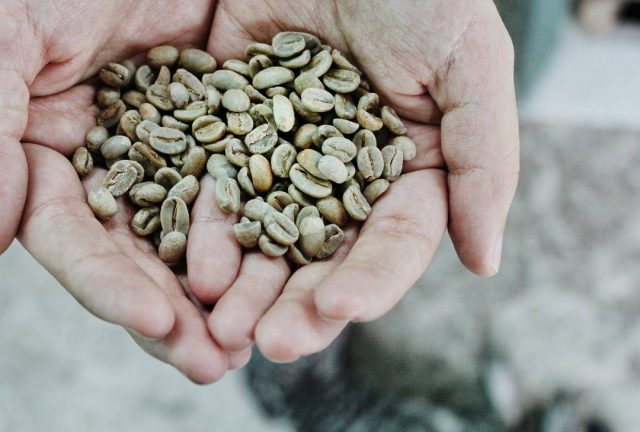Baking Guide: why is the moisture content of raw beans so important?
For professional baristas, please follow the coffee workshop (Wechat official account cafe_style)
The moisture content of raw beans may sound unfamiliar, but it is a crucial factor for high-quality coffee. It will affect how coffee is tasted, how it is roasted, and even how farmers are paid. Let's take a closer look at what the moisture content of raw beans means to bakers and farmers.

Coffee and raw beans that have just been turned in the sun
What is the moisture content of raw beans?
Although the raw coffee beans that are ready to be roasted look dry enough, they still contain water. A small amount of crystalline water dispersed in raw beans will be counted as moisture content.
Normal unprocessed ripe coffee cherries contain about 45-55% moisture after picking. The processing and drying process will reduce its water content to 10-12%. One of the ways to deal with coffee is called "washing", which requires soaking raw beans in water; however, even washing does not increase the water content of raw beans, as they must be dried before bagging.
According to Coffee International, in addition to "special coffee with traditionally high water content, such as Indian monsoon coffee", dried raw coffee beans should have a moisture content of 8 to 12.5% (resolution 407420). Of course, this does not mean that 9% moisture content is the best standard for fine coffee.
Good moisture content helps coffee produce balanced acidity and excellent aroma, which will improve the cup score. Experts have debated the most appropriate moisture content, but in the end, only 10-12% of the approximate range is generally accepted. Many bakers like the value of 12%, while the International Trade Center recommends a target of 11% for producers.
Regardless of the final percentage, if the humidity is stable, coffee beans should maintain this moisture ratio until they are in the oven. However, some climate changes may lead to further water loss during transportation. Of course, unless the bags of raw coffee beans are caught in the rain or soaked in water, it will not cause too serious impact. Unfortunately, although more and more technology and money are being invested in the coffee industry and at this critical stage, no one has been able to fully control water loss so far.

Raw coffee beans after drying
Quality control in drying process
Coffee cherries tend to ripen unevenly-some flowers may still be hanging on coffee trees at the same time, and some cherries are already red. On most professional farms, crops will be checked at multiple points during harvest and mature coffee cherries will be selected when ripe. This means that all coffee beans cannot be harvested at the same time and can not all be in the same drying stage.
Of course, it is important for farmers to label each batch of coffee and monitor the moisture content to avoid mixing batches with different moisture content. Because this may lead to inconsistencies in the quality of coffee beans, if this happens, the farm's reputation may be destroyed.
There are many different ways to dry coffee: mechanical dryer, open-air exposure, tarp sun-drying, bed drying. In a perfect climate, the elevated bed is conducive to the flow of air around the coffee, speeding up drying while avoiding fermentation and preventing mold infection.
Usually Canon will choose to set up a bed to dry, but open-air exposure also has its advantages at lower temperatures. Because the heat from the ground also helps the coffee dry. If there is no airflow, exposure on the patio will become the most useful.
However, no matter how the drying method is, it is necessary to regularly use a rake to turn the raw beans during the drying process, which is of great help to the quality. In the later stage of drying, it is generally recommended to take samples every hour to test the moisture content.

Coffee and raw beans in the sun
The risk of insufficient drying
As mentioned earlier, only beans with a moisture content of less than 12.5% can be traded.
As the weight of the coffee trade increases, the percentage of water in a raw bean is sensitive to how much money a farmer can earn. Any farmer who violates this standard will taste the bitter fruit in the future.
There is also a health problem. Fungi and molds can grow when there is too much water. Moldy beans also give off a bad smell, and these defective beans may destroy the whole batch of good beans. Even high-quality Arabica beans may not be dry enough to cause a stench, causing prices to plummet.
Storing raw coffee beans in a clean and hygienic way can reduce the risk of mildew. However, in order to completely eliminate the possibility of mildew, it is still necessary to properly dry raw beans.

The danger of excessive drying
Like insufficient drying, excessive drying can have a profound impact on costs. Farmers have to pack more beans in each bag to make up for the loss of weight. As a result, in larger plantations, farmers may throw away whole bags of coffee beans that fail in dryness. As moisture may be lost during transportation, farmers will try their best to fill the bags. This is not only a sign of politeness and kindness, but also so that more can be sold in the future.
Excessive dryness can also affect the quality and taste of coffee. For raw beans with moisture content below 9%, you can know that the aroma, freshness and clarity will be lost without baking. If the moisture content is less than 8%, then baking is meaningless because it doesn't give off any smell at all. As mentioned above, raw coffee beans with less than 8% moisture content should not be shipped at all.
When coffee is roasted, water content is also crucial. Because water is a medium for conducting heat, the water in the beans helps transfer heat to the center of the beans. As a result, due to too little moisture, the surface of the raw bean is baked too quickly and scorched off, while the internal temperature is still not enough.
Or you may say that the temperature of the roaster can be adjusted, the baking time is longer, and the heating up is slower. No, the slow roasting process will make the coffee beans smoky, which is also a bad result.

Professional boutique coffee, no detail can be ignored because it is too small. Moisture content can also have a profound effect on coffee roasting and taste.
Please complete each step more perfectly to ensure the highest quality of your coffee.
Important Notice :
前街咖啡 FrontStreet Coffee has moved to new addredd:
FrontStreet Coffee Address: 315,Donghua East Road,GuangZhou
Tel:020 38364473
- Prev

Make your own coffee-Espresso standard, adhere to the quality
Communication of professional baristas Please follow the coffee workshop (official Wechat account cafe_style) walk into the coffee shop, coffee aroma permeates, how to choose a cup of coffee you like? How to make coffee? Let the coffee expert teach you how to read the coffee menu, understand the characteristics of each coffee, and choose for yourself.
- Next

How many cups of coffee can I drink every day? How much caffeine can you get every day?
Professional barista communication Please pay attention to the coffee workshop (Wechat official account cafe_style) caffeine plays an important role in the busy life of modern people. Many people wake up with a cup of coffee in the morning, their blood sugar rises after lunch, and their heads feel drowsy. Many people will want to have another cup of caffeine to refresh themselves, such as coffee, tea, carbonated drinks or energy drinks.
Related
- Beginners will see the "Coffee pull flower" guide!
- What is the difference between ice blog purified milk and ordinary milk coffee?
- Why is the Philippines the largest producer of crops in Liberia?
- For coffee extraction, should the fine powder be retained?
- How does extracted espresso fill pressed powder? How much strength does it take to press the powder?
- How to make jasmine cold extract coffee? Is the jasmine + latte good?
- Will this little toy really make the coffee taste better? How does Lily Drip affect coffee extraction?
- Will the action of slapping the filter cup also affect coffee extraction?
- What's the difference between powder-to-water ratio and powder-to-liquid ratio?
- What is the Ethiopian local species? What does it have to do with Heirloom native species?

